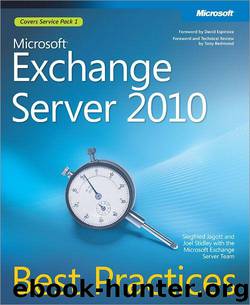Microsoft® Exchange Server 2010 Best Practices by Jagott Siegfried & Stidley Joel

Author:Jagott, Siegfried & Stidley, Joel [Jagott, Siegfried]
Language: eng
Format: mobi
Tags: COMPUTERS / System Administration / Email Administration
Publisher: Microsoft Press
Published: 2010-06-21T16:00:00+00:00
SSL Session ID
SSL session ID is generated when establishing an SSL encrypted session. The SSL session ID has a big advantage over source IP affinity: It can uniquely identify clients sharing the same source IP address. Another advantage is that there is no requirement to decrypt the SSL traffic. This is a hard requirement for using client CA because renegotiating the SSL session ID puts additional overhead on the server. Directing traffic to the same server saves processing time and prevents performance impacts.
SSL session ID does not work well with all clients. Some browsers and mobile devices, such as Microsoft Internet Explorer 8.0, create a new SSL session for each browser process. Therefore, every time a user creates a new e-mail message, a separate window opens, which creates a new SSL session. The exception to this is when users use client CA. The same SSL session ID is used for all communication to a specific host.
Outlook Anywhere and some mobile clients also open several Client Access Server sessions. Each session receives a different SSL session ID, so each session could end up being connected to a different server. As discussed earlier, this is not a problem because Windows Server 2008 network load balancing can correlate the RPC_IN_DATA and RPC_OUT_DATA; however, it does cause additional overhead and can negatively impact server performance.
Download
This site does not store any files on its server. We only index and link to content provided by other sites. Please contact the content providers to delete copyright contents if any and email us, we'll remove relevant links or contents immediately.
Secrets of the JavaScript Ninja by John Resig Bear Bibeault(8594)
Implementing Enterprise Observability for Success by Manisha Agrawal and Karun Krishnannair(8182)
Supercharging Productivity with Trello by Brittany Joiner(7421)
Mastering Tableau 2023 - Fourth Edition by Marleen Meier(7181)
Inkscape by Example by István Szép(7061)
Visualize Complex Processes with Microsoft Visio by David J Parker & Šenaj Lelić(6751)
Build Stunning Real-time VFX with Unreal Engine 5 by Hrishikesh Andurlekar(5772)
Design Made Easy with Inkscape by Christopher Rogers(5052)
Customizing Microsoft Teams by Gopi Kondameda(4591)
Business Intelligence Career Master Plan by Eduardo Chavez & Danny Moncada(4538)
Extending Microsoft Power Apps with Power Apps Component Framework by Danish Naglekar(4195)
Salesforce Platform Enterprise Architecture - Fourth Edition by Andrew Fawcett(4076)
Pandas Cookbook by Theodore Petrou(4057)
Linux Device Driver Development Cookbook by Rodolfo Giometti(4022)
The Tableau Workshop by Sumit Gupta Sylvester Pinto Shweta Sankhe-Savale JC Gillet and Kenneth Michael Cherven(3863)
Exploring Microsoft Excel's Hidden Treasures by David Ringstrom(3349)
TCP IP by Todd Lammle(3134)
Applied Predictive Modeling by Max Kuhn & Kjell Johnson(3018)
Drawing Shortcuts: Developing Quick Drawing Skills Using Today's Technology by Leggitt Jim(2996)
